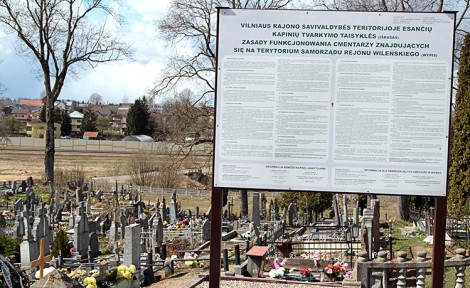- April 14, 2015
- 568
A Polish word on Lithuanian cementaries

Lithuanian nationalists, during one of their rallies against local Polish, were said to have threaten them that if they wanted to have Polish inscriptions in the public, they would get them, but on a cementary.
Even on a cementary there is no place for any Polish word. However, it is not Panka nationalists to blame for it. The real reason lies in a lack of financial means, but also in a simple negligence of Polish. On the other hand, it is hard to explain it while taking into consideration the efforts that local government makes to get Polish names on the streets.
One reader came to the editorial of „Kurier” in order to express his strong disaproval of disappearance of Polish inscriptions from the board which was situated on a cementary in the suburban areas of Vilnius.
– I have recently visited my relatives’ graves on the cemetary in Gałgy (the Vilnius area) and I noticed no board in Polish. There has been only in Lithuanian! – felt angered our Reader. He explained that before, in front of the cementary gate, there were two boards: in Polish and in Lithuanian. They provided information about the very cementary, the control of the burials and how necropolis should be used by visitors.
– The boards disappeared and now, in that place, there is one sheet of paper with information only in Lithuanian – notices our Reader.
Renata Mickiewicz, the prefect of Mickuny district, where the cementary is situated, said that in fact there were previously two boards with inscriptions in Polish and Lithuanian but for objective reasons they were removed. As a consequence, they were replaced with single notice in Lithuanian.
– It is only a temporal solution – assured „Kurier” the prefect. She explained that the previous boards were made and situated on cementaries in 2005. However, in 2011 the Board of Vilnius area agreed to have new control of burials on the cementaries. As a result, the information became invalid and the boards were removed.
– We temporarily put the text accepted by the Board which is in national language, according to the law – explained Renata Mickiewicz. She also assured us that the Board is going to prepare the translation of it into Polish. The copy will be put next to the Lithuanian version on the all seven cementaries located in the district. Moreover, the prefect told us that if in the next year the Board is able to save up money, the district will have the billingual tables done, as it was recently.
As we were able to find out, the districts of Vilnius areas manage with billingual boards on cementaries at different level. Each of them has its own solution, depending on the financial means and the intention of a prefect.
For example, on some cementaries in the district of Szaterniki, there are aesthetic boards with information in Polish and in Lithuanian. However, on the others there is nothing, even a simple sheet of paper in national language with the information about the regulation.
Translated by Anna Sulima within the framework of a traineeship programme of the European Foundation of Human Rights, www.efhr.eu.

